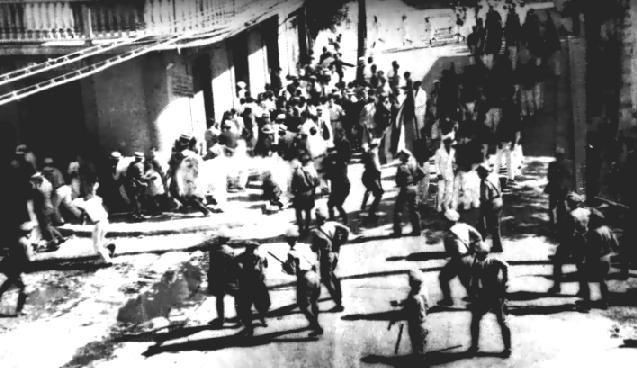Originally published at the author’s page.
As I look on at my beautiful Puerto Rico and see the people rising against colonialism and economic tyranny only to be beaten and illegally searched and arrested by a militarized police, I keep thinking about the 1937 Ponce Massacre, where 19 protestors and two police officers were killed.
On March 21, 1937 members of the Puerto Rican Nationalist Party held a peaceful march in Ponce, Puerto Rico, to commemorate the abolition of slavery (1873), protest US colonialism and challenge the arrest of nationalist leader Pedro Albizu Campos. Gaining word about the march, then-appointed Governor Blanton Winship ordered the Insular Police of Puerto Rico to stop the demonstration in Ponce—approving the use of force in this mission. (Note: Winship was appointed by Franklin D. Roosevelt in 1934).
So when protestors started marching in Ponce, the police chief’s gave the orders to open fire.


Image from Ponce Massacre (Public Domain)
Chaos ensued as protestors ran in every direction. Some police shot at the masses from roof tops while other officers deployed tear gas canisters from below. People fell on the ground, trampled by others fleeing the horrid scene.
At the end of the chaos, 19 protestors (among them youth) were killed. Two members of the Insular Police were also killed, seemingly from friendly fire. And hundreds were injured, fleeing the plaza in Ponce to nearby barrios seeking medical attention.
To cover up the role of the Insular Police in this massacre, a photo was staged. In it you see the body of a shot officer in front of Police Chief de Orbeta with other officers pointing guns towards the roofs—making it seem like the Nationalists opened fire. While the photo and the propaganda it painted circulated for a short period of time it soon became clear that the Police Chief and Insular Police were responsible for the massacre, acting under the explicit orders of Governor Winship. (For more about the Massacre, read this two-part post—Part 1, Part 2)


de Orbeta “scanning” the rooftops. (Via Wikimedia)
As we look at the present suppression of peaceful May Day protests in Puerto Rico, we must remember history like the Ponce Massacre that reminds us this shit ain’t new. Colonialism-militarism-economic tyranny-suppression of resistance has been the reality in Puerto Rico for over 100 years! Moreover, this suppression of peaceful protest is explicitly linked to US suppression historically and globally through the use of militarized police forces. We saw this in Selma in 1965, in the Los Angeles Uprising in 1992, in Ferguson in 2014-2015, in New York City in 2015, at Standing Rock in 2016-2017, and we’re presently seeing it in Palestine as well. Under U.S. empire and the governments it has supported, police forces have functioned as a paramilitary arm of the government, used to suppress expressions of disagreement and critique. This is not new.
Yet, aside from the linkages of oppressive tactics, what this history shows us is that the people will *always* rise up. In the face of colonialism, state violence, economic tyranny, suppression, the people will always resist. The people will always resist.
***
So, you want to know what you can do?
-
Learn the history of Puerto Rico that is never taught by following the #PRSyllabus and the work of scholars like Dr. Yarimar Bonilla, Dr. Marisol LeBrón, Dr. Frances Negrón-Muntaner, Dr. Arlene Dávila, Dr. Teresa Delgado and journalists like Naomi Klein, Julio Ricardo Varela (founder of Latino Rebels), Juan González, and the Centro de Periodismo Investigativo de Puerto Rico.
-
Follow the lead of people in Puerto Rico who are demanding justice and a new society (Naomi Klein shared the work of some folks in this article).
-
Walk alongside the Puerto Rican diaspora who has been living into its unique role, especially since Hurricanes Irma and María. Groups like Defend PR, La Respuesta, El Centro for Puerto Rican Studies, and activist-scholars like Rosa Clemente, Jonathan Soto, and Natasha Lycia Ora Bannan are doing a great job at sharing some of that work.
But in all things, learn with our people in Puerto Rico and the diaspora and avoid media that perpetuates ahistorical falsehoods. Because honestly, you cannot act in or out of ignorance. So learn about Puerto Rico and our history of resistance and resilience in the face of colonialism and empire. The resources are out there, and the people are resisting.
***
Jorge Juan Rodríguez V is Ph.D. Student at Union Theological Seminary in New York. He tweets from @JJRodV.


